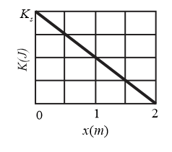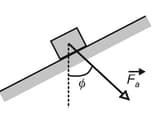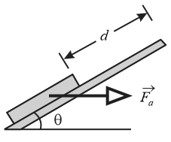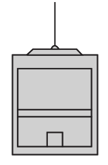A block is sent up a frictionless ramp along which an -axis extends upward. In the figure shown below gives the kinetic energy of the block as a function of position the scale of the figure's vertical axis is set by . If the block's initial speed is what is the normal force on the block?



Important Questions on Kinetic Energy and Work
A cord is used to vertically lower an initially stationary block of mass at a constant downward acceleration of When the block has fallen a distance , find (a) the work done by the cord's force on the block, (b) the work done by the gravitational force on the block, (c) the kinetic energy of the block, and (d) the speed of the block.
In the figure shown below a constant force of magnitude is applied to a shoe box at angle causing the box to move up a frictionless ramp at a constant speed. How much work is done on the box by when the box has moved through the vertical distance ?

In the figure shown below a horizontal force of magnitude is applied to a psychology book as the book slides a distance up a frictionless ramp at angle (a) During the displacement, what is the net work done on the book by , the gravitational force on the book and the normal force on the book? (b) If the book has zero kinetic energy at the start of the displacement, what is its speed at the end of the displacement?

In the figure shown below a block of cheese lies on the floor of a elevator cab that is being pulled upward by a cable through distance and then through distance . (a) Through , if the normal force on the block from the floor has constant magnitude , how much work is done on the cab by the force from the cable? (b) Through , if the work done on the cab by the (constant) force from the cable is , what is the magnitude of ?

A spring and block are in the arrangement as in the figure shown below. When the block is pulled out to , we must apply a force of magnitude to hold it there. We pull the block to and then release it. How much work does the spring do on the block as the block moves from to (a) , (b) , (c) , and (d) ?
